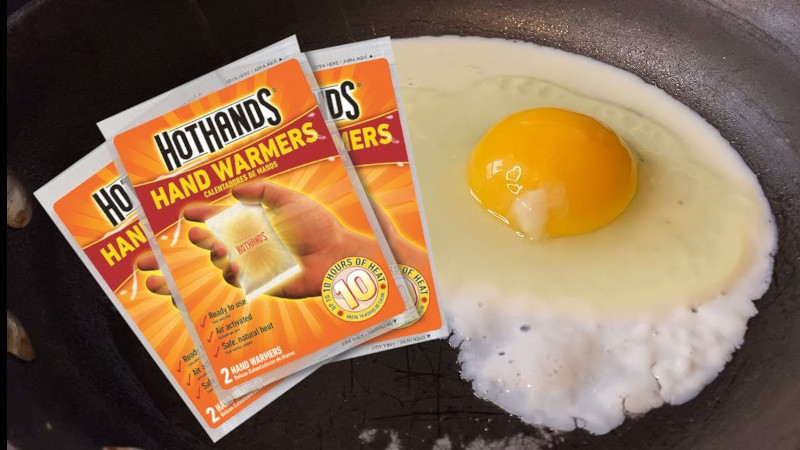Handwarmers are great to keep your fingers functional in icy weather, but can they do more? [Greg] wondered if they could be put to good use cooking an egg, and got down to work.
The handwarmers in question are the HotHands brand, based on an iron chemistry. The warmers create their heat from the exothermic reaction between iron and oxygen that creates rust. Thus, these handwarmers need plenty of airflow to heat up. To enable this, [Greg] 3D printed a small crate with plenty of vents, into which he stacked six hand warmer sachets. An egg was nestled in the center – a perfect choice as it can be cooked in its own packaging. The pile reached temperatures of 160 F and was able to maintain that level for an hour, important as egg proteins tend to start coagulating and denaturing around 150 F. Once removed, [Greg] hoped to find a solid egg, but instead was rewarded with a somewhat gooey, semi-solid result instead. Regardless, the egg had reached an elevated temperature and shown some signs of cooking, and as [Greg] appears to be still putting out videos, we’ll assume he hasn’t yet died of salmonella.
We’d love to see this turn into an engineering competition, though, with prizes for the best cooked egg with the least amount of handwarmers. We’ve featured other egg cooking apparatus before, too. Video after the break.
















Running low on news, and had to resort to this nonsense ?
This isn’t a news site, and this is definitely a hack.
Simmer down.
Haha. Simmer. I see what you did there
Don’t egg him on.
I intend to poach this idea.
How many news stories have you submitted to the HaD tip line today?
Have you done anything yourself worth HaD writing about?
They appear to have gotten paid by this ‘Greg’ fool for giving him some exposure..
Check his yt channel and the 2 HaD articles he got this week & draw your own conclusions.
Made a more in-detail post about it yesterday but that got removed, to me that just confirms my suspicions tbh.
Just in time. Omelettes for everybody!
https://pubmed.ncbi.nlm.nih.gov/32653422/
hmm…… https://xkcd.com/2420/
I was thinking more about https://www.youtube.com/watch?v=Oj0plwm_NMs
I see from that that stoves/ovens are slightly underdeveloped and with just a little more effort could be perfect for everything. ;-)
I love XKCD but the guy should watch that myth busters cooking episode and/or search around a bit, half the chart should be green.
I wonder if the effectiveness could be achieved by tweaking the mixture, since you don’t need hours to cook an egg and the need for fresh oxygen limits the upper temperature. Alternatively, imagine placing the warmers in a pressure vessel purged, then pressurised with pure oxygen (it might be handy to have an expendable, remote building to try this out).
Why not in a remote non-building aka in the outdoors? :-)
But at first you need to calculate, how much oxygen is needed
An interesting point about salmonella. There are two very different approaches to the problem practiced in different parts of the world.
The differences are described here: https://youtu.be/neJGE3Fy3PE (Warning, Simon Whistler.)
The difference is evident from where you find the eggs in the supermarket, either in the refrigerated section, or with the dry goods.
Thermite, that’s what you want.
Sorry, wasn’t meant to be a reply to you!
😆 That’ll cook it!
You best me to it :D
Technically, you can still use the iron hand warmers. The resultant rust from a used hand warmer is probably powdery enough for thermite.
I wonder if wetting the hand warmers may make it more effective?
I’ve used MRE heaters where you add an ounce or two of water to the bag and it heats up the meal in a few minutes, the stuff inside looks basically the same as what’s in a hand warmer. Though I guess it could be a more permeable packaging allows the water in to accelerate the reaction or maybe it is a different material that just looks the same.
That egg was exactly how I like my boiled eggs, I think I’ll stick with my boiling water on the hob though. :-)
You might enjoy using an immersion circulator for cooking eggs then, you can achieve the exact consistency you want every time.
I wonder if the foot warmers would work even better, i.e., get hotter when exposed to good airflow, since they are made to heat in the relatively airless environment of a shoe…
To add to the list of unusual equipment to cook eggs on, my old man used to use one of these… https://en.wikipedia.org/wiki/Hunslet_Austerity_0-6-0ST
He was driver of one on a vast industrial site in the 60s, and they used to put eggs on the steam relief valve I think it was, to cook for breakfast.
My old man was on exercise out in Germany during summer 76. They used to use the top of the track shields on their tank, but almost any metal surface would have done :)
Maybe a Haybox cooker would help with this, but then again considering the reaction needs air to work maybe not. I wonder if hitting the hand warmers with pure oxygen would speed up the reaction and release more heat?
In Great Britain hahaha we can eat raw eggs no problem.